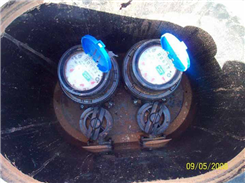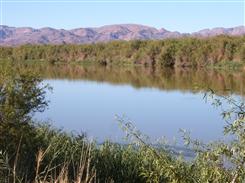Water Use
The water resources of the Orange-Senqu River basin are primarily used for irrigation. Environmental flow requirements are also pretty high, while mining, industries, power generation and domestic consumption consume much less water. Water use differs from region to region; agriculture is the major user of water in the mid- to lower reaches of the Senqu/Orange River, while industrial, mining and domestic uses predominate in the upper reaches of the Vaal River.
Table: Water use by country and industry, 2000 (Mm³).
|
|
Lesotho
|
South Africa (Upper & Lower Orange River)
|
Botswana (groundwater
only)
|
Namibia (Surface Orange River only)
|
|
Agriculture, forestry and fishing
|
19,27
|
1 828
|
0,51
|
42,78
|
|
Mining and quarrying
|
1
|
9
|
—
|
1,43
|
|
Manufacturing and Services
|
21
|
54
|
0,11
|
—
|
|
Households
|
24
|
106
|
0,51
|
—
|
|
Subtotal, all economic uses
|
43,27
|
5 199
|
1,12
|
44,22
|
|
Ecological requirements
|
No value given
|
1 743
|
No value given
|
No value given
|
Adapted from Lange et al. 2007
South Africa is the largest user of water from the Orange-Senqu River basin; it uses 97% of total annual use, including environmental flows and inter-basin transfers (Earle et al. 2005). Lesotho uses 1%, Namibia 2% and Botswana uses <1% of the total flow in the Orange-Senqu River basin (Lange et al. 2007).
Lange et al. (2007) and Lange and Hassan (2006) - The Economics of Water Management in Southern Africa - provide detailed information about water use and the economic valuation of water in the Orange-Senqu River basin. Water economic valuation case studies for Botswana, Namibia and South Africa can be found in Lange and Hassan 2006.
Allocation of Water
It is widely recognised and accepted that countries within the Orange-Senqu River basin are affected by water scarcity. In order to allocate these resources to users effectively and equitably, there needs to be a strong legal basis governing water use and management. Water supply schemes, demand management, re-use, and recycling are important considerations for water management as is collaboration between inter-basin organisations.
Abstraction permits, compulsory licensing and water-use authorisations are methods to determine and monitor water use and allocation. A typical licensing system requires a custodian of water resources who determines the allocation of these resources. This approach has been adopted and incorporated in southern African policy in recent years. Licenses and permits can be used as a tool for controlling water use, promoting equity and protecting environmental flow requirements. As physical monitoring and data gathering on water use activities is expensive to undertake and repeat on a regular basis, information gathered during licensing is often used in water use estimation.
A license to use water is issued by a responsible authority, to which a prospective user must apply. A permit is only granted after all water demands, including the environmental water demands, have been determined for a particular river or water resource to the extent possible. The demands are then compared with the reserve (the allocatable amount of water available).
The reserve equates to the environmental flow and is defined as “any water which is purposefully left in a river by restricting use or releasing water from an impoundment with the objective to maintain a river in a desired condition” (Scholes and Biggs 2004). All users are required to adhere to any conditions outlined in the permit and the responsible authorities of each country are required to enforce these conditions
 Water metering is one method for monitoring use. Source:McKenzie 2008 ( click to enlarge ) |
 Water must be allocated to environmental flows if critical ecosystems are to be maintained. Source:DRFN 2004 ( click to enlarge ) |
Botswana
In Botswana, the Water Apportionment Board (WAB) is responsible for the administration of water use licenses and rights. All major water abstractions from surface and groundwater resources must be approved by the WAB. The WAB is also responsible for controlling pollution and for approving all new boreholes and dams. Applications for the grant of a water right is made to the WAB through the Director of Water Affairs (Water Registrar) (Kgomotso 2005).
Lesotho
As per the Water Resources Act of 1978, any use other than domestic use requires a water permit (NeWater 2005). Even if you are granted a permit to abstract water there is no guarantee that there will be water to abstract, also there is no mention of organisations, be they transboundary basin organisations or any other kind in the Act. The Ministry of Natural Resources is responsible for administering the Water Resources Act and therefore responsible for regulating permits.
Namibia
In Namibia, applications for Water Abstraction Permits are made to the Ministry of Agriculture, Water and Forestry (MAWF). Currently water allocations exist for urban, mining and irrigation purposes. For urban and mining applications, the volumes are based on the predicted water demands of each development and the permits are issued accordingly. The permit allocations for irrigation are based on the area to be irrigated. Namibia has an agreement with South Africa to abstract at least 70 Mm³/yr according to Aquastat Namibia 2009 from the Orange River. Actual abstraction for 1999 was 48,8 Mm³.
South Africa
The three types of water use authorizations in South Africa are described in the National Water Act, 1998 (NWA) and Chapter 3 of the National Water Resource Strategy (NWRS; 2004) as:
-
Schedule 1 uses: which are relatively small quantities of water, mainly for domestic and stock watering purposes;
-
General Authorisations: by which limited water use is conditionally allowed without a license; and
-
Water use licenses: which are used to control water use that exceeds the limits imposed by Schedule 1 and General Authorisations.
Each type of authorisation imposes a limit and a series of restrictions on water use.
